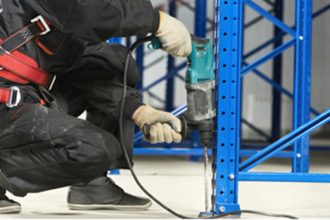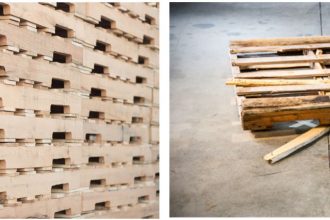Examine These 9 Components During A Rack Safety Inspection
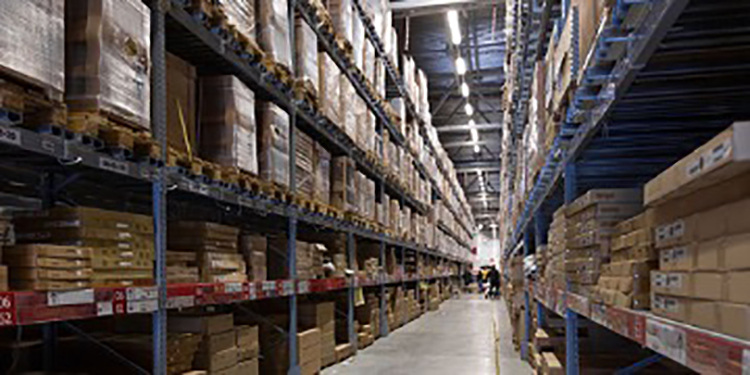
To ensure the safety and reliability of an industrial steel storage rack system, it is essential to perform routine inspections. These inspections, frequently conducted by warehouse employees or supervisors, are a visual assessment of the rack’s condition. To minimize the risk of a collapse, employee injuries, or warehouse disruptions, there are nine different components to examine during a rack safety inspection.
“The purpose of a rack safety inspection is to identify any damage caused by forklift impacts or overloading,” explained Charles Rousseau, Chief Engineer at Damotech. The company is a member of the Rack Manufacturers Institute (RMI). “Should any issues be found, it is important to promptly address them to prevent accidents or rack failures.”
The following list details the 9 racking components that should be assessed during a routine rack safety inspection.
1. Pallet Rack Uprights
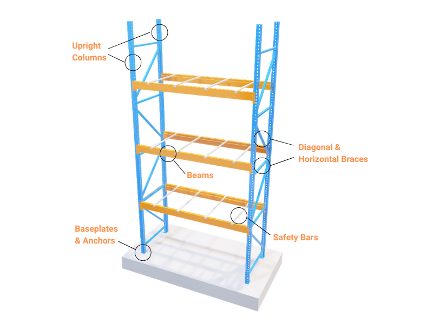 Assess the condition of every rack column during a rack safety inspection. This includes examining both front and rear columns for any signs of leaning or twisting, noted Carbonneau. “Twisted columns can greatly reduce the rack’s capacity, posing a safety risk as they may not bear the weight safely,” he said.
Assess the condition of every rack column during a rack safety inspection. This includes examining both front and rear columns for any signs of leaning or twisting, noted Carbonneau. “Twisted columns can greatly reduce the rack’s capacity, posing a safety risk as they may not bear the weight safely,” he said.
In addition to evaluating how plumb, level, and straight each column is, Carbonneau advised looking for other signs of damage or wear. These include:
- Evidence of impacts, such as dents, bends, breaks, or scuffed paint.
- Rust, which indicates a possible weakening of the steel.
- Condition of welds. Any that are separating or cracked may indicate an overloading situation or be the result of an impact.
2. Horizontal or Diagonal Braces
Braces—both diagonal and horizontal—connect the front and back rack columns between each bay and at the ends of the aisles. “Braces counter cross-aisle forces, enhancing the pallet rack system’s overall stability,” Carbonneau said. “Therefore, it’s important that they be intact.”
During the rack safety inspection, look for areas where braces are missing. Additionally, check for dents or deflections, and verify that all braces are securely connected to the uprights.
3. Load Beams
Horizontal beams bear the weight of the loads, which usually rest on pallets. Properly placed loads rest evenly on both the aisle-facing beam and the rear beam. By transferring the load weight to the connected columns, the system can safely handle heavy loads. However, cautioned Carbonneau, beams must be connected properly and securely to the columns, as well as in good condition to be effective.
“Beams will deflect, or bow, slightly when they’re holding a load,” he explained. “But if they don’t appear straight when they are unloaded, then they may have become permanently deformed by overloading and should be replaced.”
Additionally, when performing a rack safety inspection, Carbonneau advised looking at the following beam conditions:
- Beam connectors or clips should be securely attached to the columns.
- Safety pins should be present and in place.
- Bolts should be properly (not over or under) torqued.
- Beams should not appear to be overloaded.
4. Pallets
Although it may not seem intuitive, pallets are a critical component of overall rack safety. Because a rack engineer designs the system to accommodate a specific type of pallet and load, it is important to verify that the right type and size of pallets are being used.
Further, Carbonneau said the condition of the pallets themselves is crucial to rack system safety. “To properly support a load, every pallet must be intact and in undamaged condition,” he said. “Otherwise, they could cause load instability which can negatively impact the rack structure.”
During the rack safety inspection, it’s essential to look for pallets showing signs of damage. These include cracks, broken boards or stringers, missing boards, discoloration, odor, outdated labels, protruding nails, or improper load distribution on the pallet.
“Any pallets that appear damaged should be removed from the rack and their load transferred to a pallet in good condition,” added Carbonneau.
5. Base Plates and Anchor Bolts
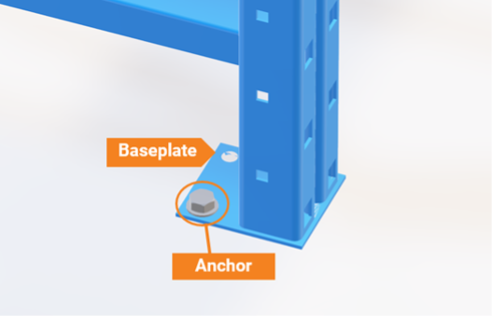 At the foot of each rack column is a base plate (sometimes called a footplate). Welded to the upright, base plates distribute the weight of the system to the facility floor. Anchor bolts secure base plates to the floor, further connecting the structure to the facility.
At the foot of each rack column is a base plate (sometimes called a footplate). Welded to the upright, base plates distribute the weight of the system to the facility floor. Anchor bolts secure base plates to the floor, further connecting the structure to the facility.
“Per rack industry standards, at least one anchor per baseplate is required to secure the racking system to the floor,” Carbonneau said. “This significantly enhances the rack’s ability to withstand various forces.”
If the base plates are damaged or anchor bolts are missing, broken, loose, or bent, the system won’t perform as expected in the event of an earthquake, he continued. “Likewise, damaged anchor bolts also impair the system’s resistance to wind, overturning, shear forces, or accidental impacts on the lower ends of the columns.”
6. Safety Bars
Some installations incorporate safety bars, which span the distance between the front and rear beams. Also known as load supports, these accessories provide temporary support for misplaced pallets, reducing the chance of them falling.
“Safety bars are not mandatory, but their use can significantly reduce the risk of accidents that may result in severe employee injuries or damage to goods and storage systems,” noted Carbonneau.
Operations that utilize safety bars should pay attention to the following points when conducting rack safety inspections:
- Verify that all safety bars are in place and secured to the beams.
- Confirm proper positioning of the safety bars. This is typically at the first and third quarters of a pallet’s width, Carbonneau said.
- Ensure that the safety bars are preventing pallets from falling through the beams.
- Verify that there are two safety bars per pallet position.
7. Signage and Documentation
A rack safety inspection should also verify that the system’s load application and rack configuration (LARC) drawings are on file in the facility. They should also confirm the beam configuration matches an approved option specified by the original rack manufacturer. Likewise, personnel conducting the inspection should check for the presence and condition of load capacity plaques, which state the system’s maximum rated load.
8. Floors and Aisles
Because the floor slab supports the weight of the racking system and the loads it holds, it is important to observe its conditions. Carbonneau advised looking for cracks or damage near the base plates of the racks.
“Cracks in the concrete floor can compromise the stability of the racking,” he said. “Likewise, any damage to the flooring around base plates might indicate an impact occurred.”
Carbonneau also recommended that rack safety inspections assess the state of the aisles. “Keep the aisles between your racking systems clear and uncluttered,” he said. “Also, using proper lighting and providing ample space for forklift operators to navigate will reduce the chances of rack impacts.”
9. Protective Guarding
Broadly speaking, protective guarding accessories for racking systems generally fall into one of two categories. One type are devices that contain pallets and products should they fall, said Carbonneau.
“Nets, screens, or wire mesh decking prevent objects from falling into walkways where pedestrians circulate,” he explained.
The second kind is guarding that shields the racking against forklift impacts. “These are usually installed in high-traffic areas, or at the end of aisles,” he noted.
If an operation is using any of these accessories, the rack safety inspection should assess their presence, correct installation, and condition. Any damaged or missing devices should be replaced immediately, added Carbonneau.
Want to Learn More About Rack Safety Inspections?
RMI offers a list of frequently asked questions and an MHI Cast podcast about safety inspections. Additionally, the group has produced a Safety Inspections Video.

